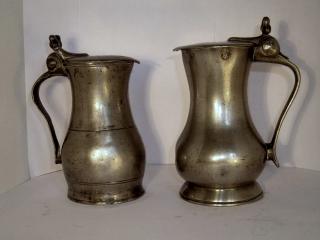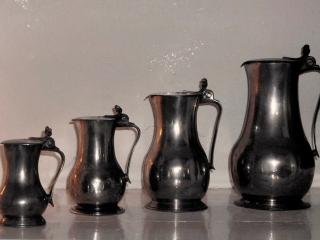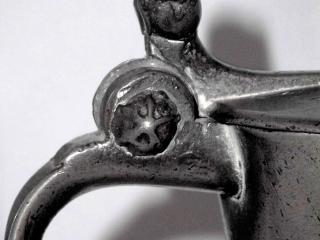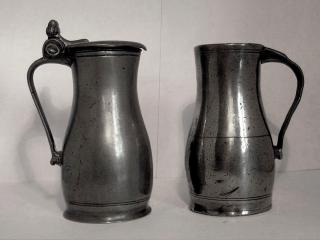Channel Islands pewter
Pewter of the Channel Islands
The four main Channel Islands comprise Jersey, Guernsey, Alderney and Sark and are a special place for pewter being influenced by both France and England. The islands were at the time of the Norman Conquest part of the Duchy of Normandy and have remained part of the Crown possessions ever since.
The population were largely poor working on the land, fishing and knitting. The local government was best described as feudal and pewter abounded in the manor houses but also throughout the population where cider drinking was the norm.
25% of the land in Jersey was given over to apple orchards in the early 18th century and annual production was estimated at 1 ½ million gallons. That is 12 million pints a year.
With around 15,000 cider drinkers on Jersey out of a population of 20,000 that suggests over 2 pints per day consumption for each person.
The domestic cider trade on the Channel Islands was protected by prohibition and later duty on the importation of alcoholic beverages.
Taverns abounded and the tavern pots had a hard life with surviving pieces having battered concave lids, witness marks on the handle and dented bottoms testifying to excessive wear.
The persecution of Protestants in France had driven immigration to the Channel Islands and there were two periods which saw the most significant numbers of refugees leaving France.
The first wave was following the St Bartholomew Massacre in 1572, and the second was following the Revocation of the Edict of Nantes in 1685 which had given protection to the Protestants.
Some refugee families stayed in the islands, but many used it as a temporary refuge, before emigrating further afield.
So when did pewter manufacture start on the Channel Islands?
The earliest dated piece is from St John’s Church on Jersey and this was donated to the church in 1718. It was by the Huguenot pewterer PDR with his mark on the lid.
There are however intriguing references to the Jenne family in Jersey in court records dating back to the early 16th century. However, some of the surviving Jersey pots probably date back only to the early seventeenth century and show a close resemblance to those of Rouen in the 16th century. The earliest reference to pewter on Guernsey is in a law of 1611. Perhaps French or English styles were in use with a hybrid made locally. No doubt much everyday pewter was destroyed and recycled just as in England where pre 1600 artefacts are rare apart from spoons and Church pieces.
The distinctive style difference between Jersey and Guernsey is well illustrated by these two rare half pint measures.
The Jersey has a long incurved neck going down to the bulbous belly. At the base the body curves outwards to form a foot rim usually finished with a small convex or splayed moulding.
The body surface is plain apart from incised lines just above the base and below the rim.
On the larger sizes the body is normally plain although this small half pint has central lines decorating the bulbous body.
The lid is heart shaped and pointed at the front to match the simple pouring spout.
The twin acorn thumb piece is set at about 90 degrees and there is a single flanged lid with a wedge of varying length.
Touch marks if any are inside the lid.
The owner’s initials are scratched on the handle and there are local
verification marks of a crowned GR to the lip.
There are six capacity sizes; the largest being called a pot (pronounced po).The next size is a quart followed by pint, half pint, noggin and half noggin. There are the same sizes in unlidded Jersey measures.
Guernsey measures have their identification marks on top of the lid.
The later ones have a shape somewhat akin to Jersey measures as can be seen from the four sizes shown here by Nicolas le Cheminant.
These Nicolas le Cheminant pieces were definitely used as measures on the Island and often carry the characteristic verification marks of a rose and a fleur-de-lys struck on opposite sides of the measure near the rim.
On Guernsey measures the owner’s or merchant’s initials are on the top of the lid and are stamped from individual punches and not scratched or chiselled as on Jerseys. Handles are strap like.
Moving to the mid-18th century, we illustrate two measures by ISDX
a Jersey pot and quart which were made in London and exported to the Channel Islands.
Here are two of the smallest size lidded and unlidded; unmarked but unmistakable pretty Jersey noggins.
With such stylish form and intriguing detail who could not fall in love with the pewter of the Channel Islands!
Andrew Ferrar
March 2019




